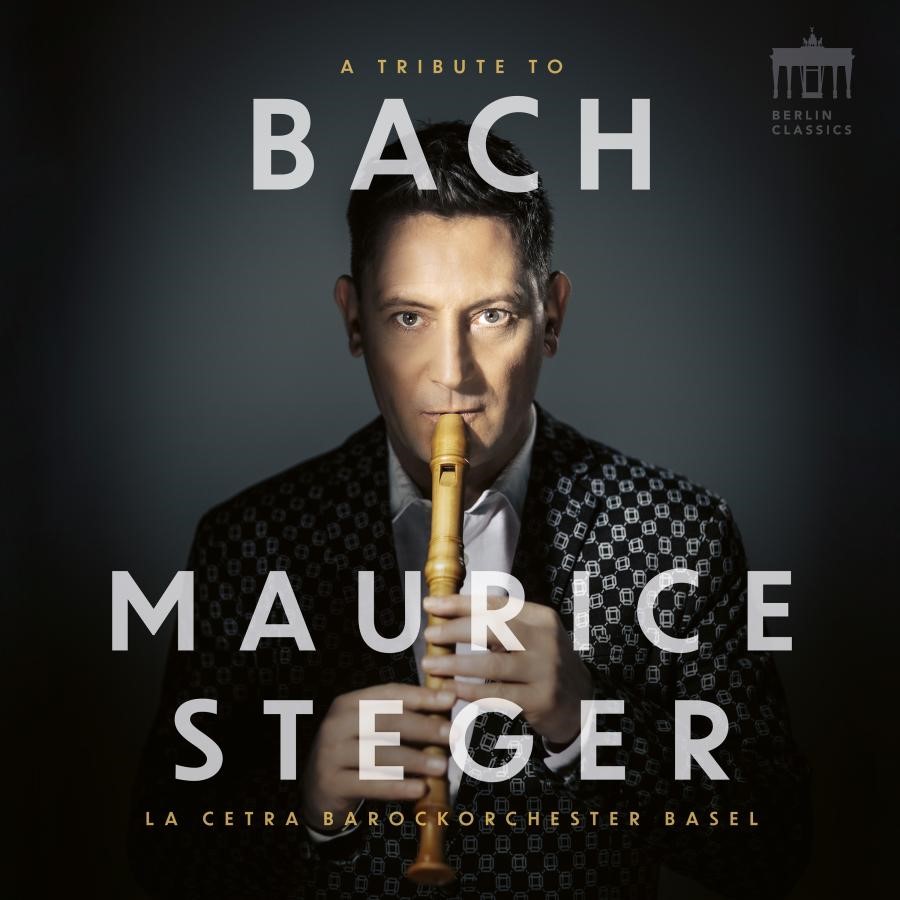Discography
| Concerto in D Major for recorder, strings & b.c | ||
| 1 | Allegro | 7'44 |
| 2 | Improvisation | 7`00 |
| 3 | Alla Siciliana | 06`07 |
| MAURICE STEGER, recorder LA CETRA BAROCKORCHESTER BASEL Reconstruction by SEBASTIAN WIENAND |
||
| 4 | Ricercar in c Minor à 6 from the Musical Offering | 7'17 |
| I. MAURICE STEGER, recorder; II. KATHARINA HEUTJER, violin; III. PRISKA COMPLOI, oboe da caccia; IV. REBEKA RUSÓ, viola da gamba; bassoon; VI. JONATHAN PEŠEK, cello; ALEX JELLICI, viola da gamba; FRED WALTER UHLIG, violone |
||
| Sonata g Minor for recorder and obbligato harpsichord | ||
| 5 | Allegro | 4`15 |
| 6 | Adagio | 3'2 |
| 7 | Allegro | 3'3 |
| MAURICE STEGER, recorder; SEBASTIAN WIENAND, harpsichord | ||
| Triosonata in d Minor for recorder, violin & b.c. | ||
| 8 | Andante | 4'29 |
| 9 | Adagio e dolce | 3'47 |
| 10 | Vivace | 3'13 |
| MAURICE STEGER, recorder; KATHARINA HEUTJER, violin; JONATHAN PEŠEK, cello & viola da gamba; DANIELE CAMINITI, theorbo; FRED WALTER UHLIG, violone; SEBASTIAN WIENAND, organ |
||
| Sonata in E Major for recorder & b.c. | ||
| 11 | Adagio ma non tanto | 2'42 |
| 12 | Allegro | 2'55 |
| 13 | Siciliano | 3'55 |
| 14 | Allegro assai | 2'5 |
| MAURICE STEGER, recorder; JONATHAN PEŠEK, cello & viola da gamba; SEBASTIAN WIENAND, harpsichord | ||
| Concerto in F Major for harpsichord, two recorders, strings & b.c. | ||
| 15 | Allegro | 6'19 |
| 16 | Andante | 3'47 |
| 17 | Allegro assai | 4'17 |
| SEBASTIAN WIENAND, harpsichord; MAURICE STEGER & CLAUDIUS KAMP, recorder; LA CETRA BAROCKORCHESTER BASEL | ||
| MAURICE STEGER | recorder & conductor |
| LA CETRA BAROCKORCHESTER BASEL | |
| KATHARINA HEUTJER, ILDIKÓ SAJGÓ, RAHEL WITTLING | 1. violin 1 |
| ÉVA BORHI, CECILIE VALTER, LUKAS HAMBERGER | 2. violin 2 |
| PÉTER BARCZI, JOANNA MICHALAK | viola |
| JONATHAN PEŠEK, ALEX JELLICI | cello |
| FRED WALTER UHLIG | violone |
| CLAUDIUS KAMP | bassoon & recorder |
| PRISKA COMPLOI | oboe da caccia |
| REBEKA RUSÓ | viola da gamba |
| DANIELE CAMINITI | theorbo |
| SEBASTIAN WIENAND | Cembalo & Orgel |
A Tribute to Bach
This album already carries the intention in its title: “A Tribute to Bach” is meant to be a deep bow by the world-renowned recorder player Maurice Steger to the great master of the music world, Johann Sebastian Bach.
For his Bach project, Maurice Steger has chosen six compositions that follow six different musical genres and placed the recorder at the forefront of solo instrumentation. In doing so, he places himself in the tradition of Bach himself, who has been proven to have repeatedly undertaken new instrumentations for his works in the course of his life. The result in terms of sound is fascinating: Bach becomes a convincing recorder player through Maurice Steger’s interpretation.
First up is the Concerto in D major for recorder, strings & b.c., BWV 1053 R. He is accompanied here by the multi-award-winning La Cetra Barockorchester Basel, with whom he already collaborated on his last album. The orchestra fulfils all wishes that could be placed on a baroque orchestra and consists exclusively of specialists for early music. The following excerpt from the cycle “Das musicalische Opfer” (BWV 1079), the Sonata in G minor (BWV 1020), the Trio Sonata in D minor (BWV 527), and the Sonata in E major (BWV 1035) feature soloists from the La Cetra Baroque Orchestra. Among others, violinist Katharina Heutjer, harpsichordist Sebastian Wienand, cellist Jonathan Peśek and recorder and bassoonist Claudius Kamp should be mentioned here.
At the end, the full richness of the fantastic orchestra is heard again in the Concerto in F major for harpsichord, two recorders, strings & b.c., (BWV 1057). These works span several important stages of Johann Sebastian Bach’s life and were written in the span between 1721 and 1747. Some of them were written in Köthen, and one of the works, the Sonata in E major, was demonstrably composed on a trip to Berlin. Later, in Leipzig, Bach reworked or completed many of his works. In the case of the G minor Sonata, the authorship could also lie with his son C.P.E. Bach, but experts are not entirely sure. Bach created the works for special occasions and clients, or for friends and highly talented musicians of his time.
It is indeed known that Bach himself also played the recorder, especially in his youth. Even then, the recorder was the “beginner’s instrument” with which one could easily learn basic musical skills such as note reading, rhythm and intonation. It is true that Bach used the recorder with great refinement in many works, but unfortunately there are no records of his pure recorder works. We therefore cannot say with certainty how his music would sound for recorder, but as we know, his music leaves much room for interpretation and experimentation. Bach’s notations are often very detailed and contain specific instructions, but his music is so profound and complex that there are different ways to interpret and express it.
The music on this album changes from mad instrumental virtuosity to very gentle forms of expression, as only a true master of the recorder can gallantly sound. A recorder player like Maurice Steger cannot bow more beautifully and gracefully to Johann Sebastian Bach.
Recording
12th – 15th October 2021 | Basel, Martinskirche
Sound engineer & producer: Christian Sager (www.sagersounds.ch)
Photography
Nikolaj Lund (www.nikolajlund.com)
Production
Berlin Classics, Edel Music & Entertainment GmbH

